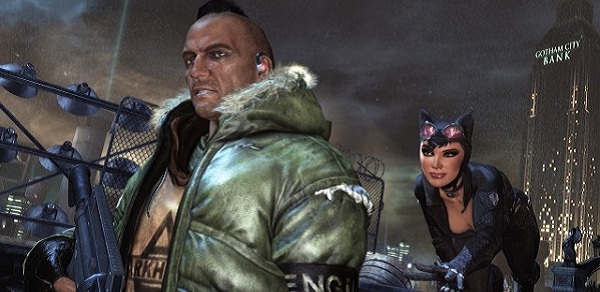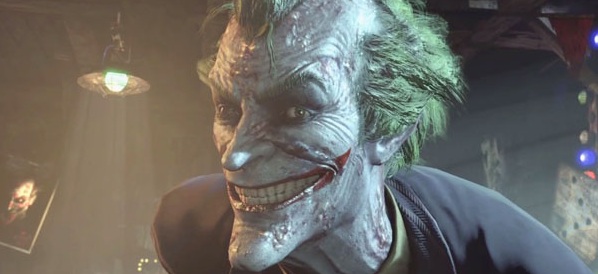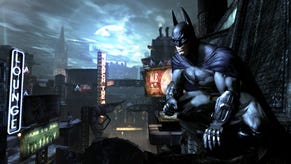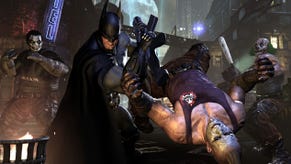Wot I Think: Batman Arkham City
A Knight On The Town
Bruce Wayne has finally returned to my PC, ready to swoop and scuffle his way through the prison-district that is Arkham City. It’s no secret that I used to wear Batman pajamas when I was a youngster, nor that I have been known to shed manly tears when thinking of the Caped Crusader’s tragic origins in Crime Alley. These facts make me the ideal person to tell you Wot I Think of this new crimefighting caper.
It certainly feels like a long time has passed since Rocksteady’s first triumphant stab at the Bat and I have to remind myself that it’s quite an odd thing to be so excited about the release of a Batman game. When I first played Arkham Asylum, it seemed so ambitious, going all out to capture the feeling of being inside the cowl and cape. The freeflow combat system made Batman, even with his lorry-like torso, seem agile and animal-like, as well as bone-crunchingly powerful. The predator sections combined stealth with clever, if repetitive, use of the environment and the brief moments of investigation, though hardly in depth, showed that Batman was about more than savage takedowns and shadowy thug-stalking.
The garnish on the delectable bat-feast was the extensive use of the license. It’s one thing to make a game in which the player controls Batman, pugnaciously detecting his way through a mob of henchmen and villains, but Rocksteady went further than that, using the Riddler as a kind of guide to the wider world outside the asylum. Rather than stumbling across a few easter eggs dotted around for the devoted, the completionist found a willing partner in the attention-seeking Riddler, goading them to defeat him in a battle of wits. Except it wasn’t a battle of wits at all; it was a way to connect a loose subplot to the wealth of references and detail that Rocksteady scattered through the Arkham’s grounds.
These are the essential components that make Batman what he is: punching, hiding, seeking, scaring, investigating and hanging upside down to express contemplative moodiness. Arkham City does all of those things better than Arkham Asylum and, for some people, that will be enough. After all, those are the necessary tools that allow the player to be Batman and they fulfil that function superbly. Where they were previously lacking, they’ve received some attention and even the excellent combat system is more enjoyable to use. Mostly, this is by upping the scale. Investigations don’t always take place in a single room, or following a single trail, but can require Batman to effortlessly swing his way across rooftops, unlocking multi-part subplots, and perhaps even stopping on the way to save a political prisoner from intimidating meatheads.
The expansions to the combat system add complexity to the mix. Enemies can now have a variety of tricks up their sleeves, clutched in their shovel-sized hands and strapped to their bodies. Just as the first game punished Batmen who ran around stringing together simple combos, throwing in knives and stun batons that demanded a quick twirl of the cape or a vault over the head, Arkham City will let you pummel your way forward like a trim Adam West for a while, but before long that won’t be enough. As with everything else, brawls are often bigger, with even an accidental street fight sometimes seeing Batman take on upwards of ten mobsters. That should be called a murder of mobsters but sadly it isn’t. It’s probably nothing more than a mob of mobsters.
As soon as the game’s title was announced, I was filled with a degree of trepidation about the fact that it would probably be set in a more open world. Arkham Asylum allowed exploration but the player was always directed through each area. I liked that. This was a focused Batman adventure, not a flawed Batman simulator. Thankfully, Arkham City, despite including a great deal more detours, always guides the player toward the objective that advances the plot. There is freedom to explore other narrative beats, something which Asylum didn’t really cater for, but they are often to the detriment of the storyline’s urgency. Batman has the option to be as heroic as he wants, with a plethora of villains and distressed citizens clamouring for his attention, but Arkham City’s story is built on several overlapping time-sensitive threats, so to deviate from it involves suspending disbelief like a miscreant from a balcony.
The noisiness of the city is the main problem with the game. As Alec noted, where Arkham Asylum was ‘tight’, Arkham City is a little baggy. It seems almost silly to complain when a game contains too much but in this case, it’s a complaint I feel justified in making. It’s hard to take a couple of steps without hearing a cry for help or a desperate plea for attention from one of the many attention-seeking maniacs causing havoc in the streets. The Riddler is one thing, having spent what must have been a small fortune and a great deal of time decorating the place with his signature question marks, but there are also serial killers to hunt and hitmen picking off victims. Rocksteady worked wonders for the license in Arkham Asylum, but here it’s almost as if they’ve felt compelled to include everything they possibly can.
Most of the time, that’s a good thing. When a seemingly innocuous side mission led to an encounter with a fairly obscure and unexpected villain, I was delighted. But during the segments in between missions, when the player can either head straight for the next plot beat or create some beats of his/her own, the situation becomes comical. With the Joker babbling demented commands and sweet nothings in Batman’s pointy ears, it becomes necessary to ignore the screams of the innocent and the cackling of their assailants because there are simply too many other things to do. It’s like having a to-do list that constantly expands; eventually, you’re going to skip going for that 30 minute jog you resolved to do every night. Except in Arkham City, the 30 minute jog is rescuing someone who is about to have their face cut off.
It’s an overrun prison going to hell, so of course it’s busy, but it can be overwhelming. It’s to the game’s enormous credit that most of the time I was happy to take on almost everything it threw at me. There’s very little that isn’t fun to accomplish, but like a kid in a candy store, it’s easy to overload on tasty but lesser things before finding the pear drops.
The grab-bag approach is evident in the boss battles as well, which are improved but remain the most disposable parts of the game. At times, it’s easy to imagine a finger scrolling down a list of villains, then alighting on someone too large or mystical to punch into submission. Drop him in the game for variety and pace. Done. That leads to a lack of cohesion, with the overtly fantastical and supernatural enemies existing inside a world that leans toward the gritty and the grim. While many have criticised Nolan’s approach, I’d argue that he does at least have a solid vision of how Batman’s world is constructed. Rocksteady seem to have lost that, sometimes aiming for a deluded ‘realism’ of violence, crime and despair, and sometimes plumping for magical mayhem.
It’s not that the two can’t co-exist, but they feel like uncomfortable bedfellows here. The writing doesn’t help. I do like this Batman, with suitable voice work from Conroy as always, but many of the villains are bland. The female characters do come off badly, primarily because not a single one is interesting. There are enough sexual references to Harley that I cringed whenever her name was mentioned. It’s as if there’s nothing much else to say about her, which is lazy writing at the very least. I actually found Catwoman worse though: when Batman is faced with almost certain death, he finds strength to go on in his ideals and legend. When Selina Kyle is faced with the same, she resorts to innuendo and flirtation. There isn't enough nuance to the character as Rocksteady present her for it come off as anything more than trite.
Let us all be thankful for The Joker then, as well as Mark Hamill who strikes the perfect tone between menace and hilarity. I found myself sympathising with him, purely because he’s the only person in the game with a sense of humour. He seems to know that the whole situation is ridiculous and he revels in it, while everyone else fails to raise an eyebrow at even the most ludicrous developments.
The most challenging sections of the game tend to be the devious predator rooms, wherein Batman perches on high and gently encouraging inmates to suffer nervous breakdowns and, despite the claims of more thoughtful tasks worthy of the world’s greatest detective in this sequel, it’s the stealth and stalking that has received the most attention. A common way to expand a tried and tested game mechanic is to provide the player with more tools and that’s something that Arkham City does, keeping its promise of leaving Batman with a fully stocked utility belt and adding to it with a few new devices. Some of these help when faced with a room full of armed gangsters, but as with the melee combat, it’s the new equipment given to the enemies that makes the biggest difference.
While their dialogue suggests they are unimaginative and uneducated slabs of meat with nary an interesting thought in their gruesome craniums, the inmates of Arkham City seem to know a little about Batman and his modus operandi. It makes sense, since they seem incapable of fixing their thoughts on little else, except the merits of their respective bosses, the joy of inflicting cruelty and the bleak concept of starving to death in Hugo Strange’s unruly compound. Despite the fact that, as I overheard one perceptive lunk announce, they have been imprisoned in “a mass grave”, just about every inmate struggles to shake the spectre of Batman from his mind. That’s as it should be. Zipping across rooftops and picking up a conversation in the streets below, it’s always tempting to stop and drink in the ripples of fear that your shadow has cast over the world.
But they are smarter, the inmates. Not usually smart enough to cease their taunting and run away, but smart enough to understand some of Batman’s tricks. Spend too long above them, picking off prey, and they will sometimes start to destroy those precious gargoyles, or whatever arbitrary architectural anomaly is in the area. As the game progresses, most of Batman’s tricks find their counter in a new piece of equipment that the gangs start to deploy.
It can make some of the later rooms a real challenge, particularly playing on hard, which I’d recommend for anyone who has completed Arkham Asylum. Admittedly, there’s a little disappointment in clobbering crowds of crooks and then crumpling to the ground, your Batmanliness undone, after one too many slaps to the chops. Batman shouldn’t fail quite as pathetically as I so often did and reloading feels like cheating. He wouldn’t reload. He’d just drag himself back to his feet and carry on fighting. But the higher difficulty is worth it because none of this should feel easy. Remember how Batman looked progressively worse for wear as the night progressed in Arkham Asylum? By the midpoint of Arkham City he looks like he’s had a fight with a threshing machine. This is most definitely one of the more demanding excursions in his long and arduous crimefighting career.
In many ways, it seems that Rocksteady were just finding their feet with Arkham Asylum, then dipping their newly-discovered toes into Batman’s mythology and telling a self-contained story. With Arkham City they are making Batman their own, with a story that rewrites the landscape of Gotham and is incredibly bold in its treatment of the extensive cast. I’m glad they have the confidence and permission to do that, because it helps to make this much more than a retread. But it also means that rather being the pure refined stuff that was at the heart of their previous success, Arkham City is an ongoing project. There will surely be another game in the series, but it’s hard to tell quite what it will be.
The most exciting thing about Arkham City, beyond the sheer joy of actually playing, is that it’s not just more of the same. It’s more of everything else as well, which can be detrimental. But despite perhaps sounding overly critical of some aspects, I wouldn’t hesitate to say it’s one of the best games I’ve played this year. There is an enormous amount to do and now that I'm finished, I feel free to do it, no longer constrained by the fate of Gotham I can solve all those side stories. And even though I have a redwood-like backlog, I think that’s exactly what I’m going to do.
It’s a shame we had to wait longer for the game to come out on PC, a feeling that’s exacerbated by the issues with dx11. It means this version isn’t yet as definitive as it should be, although it is, even without those extra bells and whistles, an extremely beautiful game. I find myself entranced by the snowflakes that dot across Batman’s cape. I should be a bit more miffed about the extra time afforded by the delay not being used to ensure there were no launch problems. I'd like to know the real reasons behind it all and I hope the issues are sorted sooner rather than later, but coming off the back of completing the game for a second time, I find it hard to be annoyed about much at all. Disappointed in certain aspects, sure, but overall, absolutely delighted.













